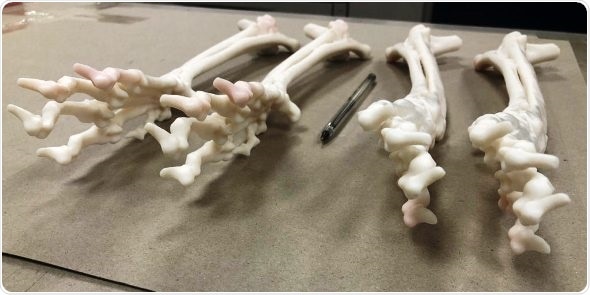3D-printed human body parts with lifelike bone, skin and muscle densities are being developed in South Australia as teaching aids for surgical training.

Replica dog leg bones to help veterinary surgeons plan an operation to correct bowed legs in a dog.
The medical devices can also be designed with built-in pathogens such as tumors, bone fractures or defective hearts to allow surgeons and students to practice specific procedures.
An experienced and respected conventional printer in Australia, Mark Roe founded Fusetec 3D in Adelaide in April 2017. After spending time researching in the United States and speaking to surgeons and academics in South Australia, Roe bought a state-of-the-art 3D printer in April 2018.
Roe said that although similar technologies were being used for research and patient-specific modeling at universities and medical centers in North America and Europe, his system was the only purely commercial operation of its kind in the world.
“It was hard to get momentum, nobody was really taking us seriously so I had to take a great leap of faith in what I believed would be a good commercial market and buy the equipment with the theory of build it and they will come and that’s pretty much what is happening,” he said.
“We’re starting to get a lot of demand now, most of our demand is coming from export, driven by inquiries from China and the US.
“The main benefit with this machine is we can replicate human tissue density – they can operate on it, they can sew it and they can drill the bones so it simulates a human cadaver.
“You can change density from bone-like to skin-like to muscle-like all in the same print job.”
Fusetec 3D manufactured its first commercial product in May and has so far completed a number of bespoke jobs including dental simulation units for the University of Adelaide and a replica set of four dog’s legs to help veterinary surgeons develop techniques to correct bowlegs.
The company also has Fusetec 2D, which Roe started with John Budgen in 2017 to help provide cash flow for the 3D business by printing high quality corporate, university and government documents.
Roe said the real IP in Fusetec’s manufacturing process lay within the files they generated to determine the density, color and feel of the photopolymer base materials to achieve the life-like results.
“To make a head we are working on we broke it down into 128 different files so that means we allocated 128 different colors and densities of material textures,” he said.
“There’s no limit to the amount of files or the combinations of colors or material densities that we can use in one product, it’s just a matter of how big the file is.
“The biggest problem is the development cost and the time to develop but once we have the file we can mass produce.”
Fusetec is looking to start selling its first ‘off the shelf’ product next month and gradually build its catalog to 10 products before beginning to sell globally.
“We’re starting to get a lot of demand now, most of our demand is coming from export, driven by inquiries from China and the US.
“The main benefit with this machine is we can replicate human tissue density – they can operate on it, they can sew it and they can drill the bones so it simulates a human cadaver.
“You can change density from bone-like to skin-like to muscle-like all in the same print job.”
Fusetec 3D manufactured its first commercial product in May and has so far completed a number of bespoke jobs including dental simulation units for the University of Adelaide and a replica set of four dog’s legs to help veterinary surgeons develop techniques to correct bowlegs.
The company also has Fusetec 2D, which Roe started with John Budgen in 2017 to help provide cash flow for the 3D business by printing high quality corporate, university and government documents.
Roe said the real IP in Fusetec’s manufacturing process lay within the files they generated to determine the density, color and feel of the photopolymer base materials to achieve the life-like results.
“To make a head we are working on we broke it down into 128 different files so that means we allocated 128 different colors and densities of material textures,” he said.
“There’s no limit to the amount of files or the combinations of colors or material densities that we can use in one product, it’s just a matter of how big the file is.
“The biggest problem is the development cost and the time to develop but once we have the file we can mass produce.”
Fusetec is looking to start selling its first ‘off the shelf’ product next month and gradually build its catalogue to 10 products before beginning to sell globally.
He said interest from teaching universities there had been so strong that he had since appointed a consultant and a lawyer in China to help manage demand.
Fusetec is also working closely with South Australia’s three public universities, University of Adelaide, Flinders University and the University of South Australia.
“I’ve also got relationships with several universities on the (Australian) eastern seaboard,” Roe said.
“Surgical training is probably one of the last professions where there is very limited real-life training,” Roe said.
“By manufacturing these medical training devices, we’re overcoming that problem. They can actually do life-like training but on a mannequin, they can have repetitive training and they can have training with pathologies.
“Anything that can be surgically operated on we can manufacture a medical training device for.”